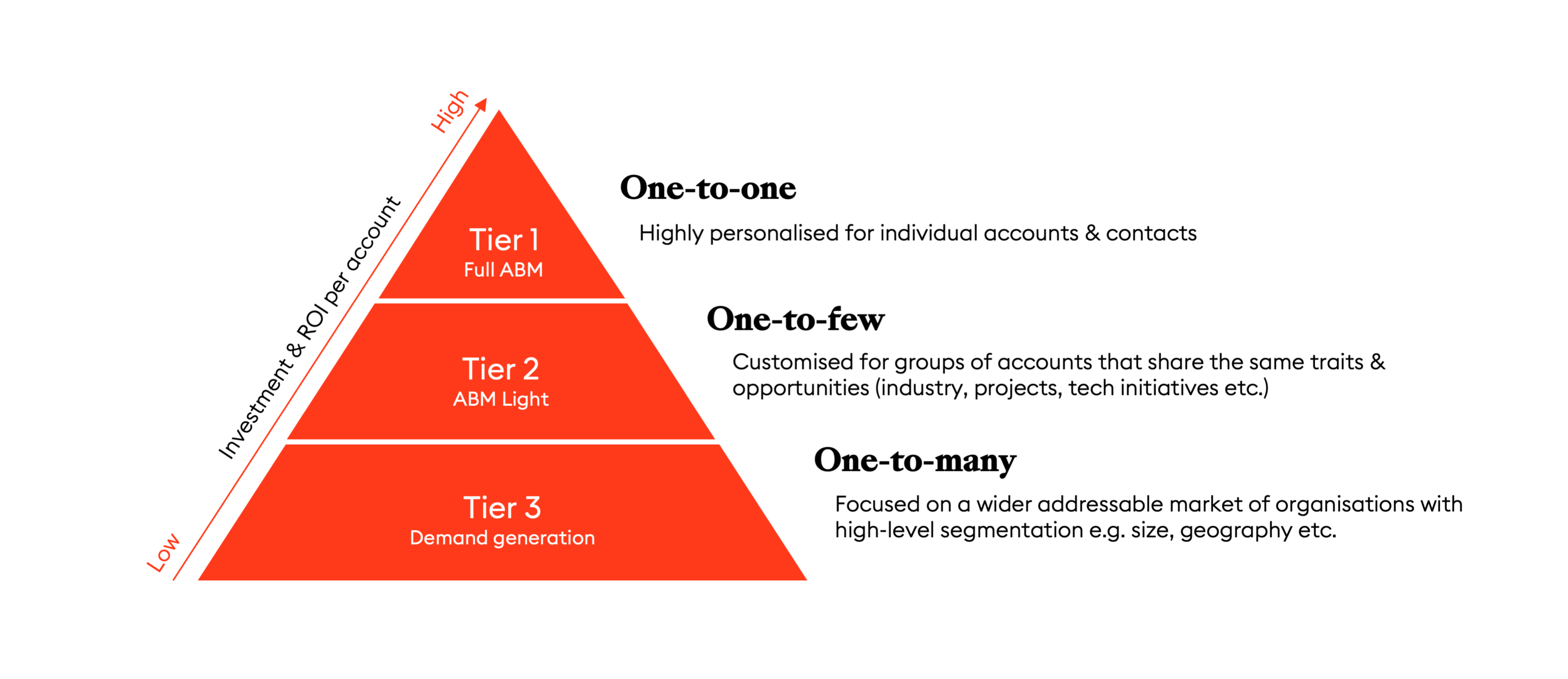
Account-Based Marketing (ABM) was once reserved for large B2B enterprises, able to dedicate a whole marketing programme to a single account. Now it’s becoming the go-to marketing strategy for B2B companies of all sizes. Yet, adopting ABM comes with a huge health warning. You can’t just switch it on and put a stop to everything else. If you’re thinking of implementing ABM for the first time, tread carefully. This blog provides some real-life lessons from the ABM trenches to help you avoid making some common mistakes.
More technology and consulting companies are embracing ABM, albeit at varying stages of maturity. From the 'one-to-one' approach introduced by ITSMA back in 2004, ABM has now become a more scalable strategy that can be deployed across many accounts simultaneously - largely thanks to advances in marketing technology. This has led ABM to become more accessible to everyone, but it has also blurred its lines with traditional demand generation.
As we’ll explain, definitions are really important here. The very idea of ABM has been diluted from its one-to-one origins to something more pervasive and much harder to define. And this is why marketers need to be careful.
With the continuous pressure on marketing to support new business and revenue growth, more advanced approaches to improve performance are always welcome. Yet, marketers touting ABM as the next panacea need to be mindful. ABM is not a quick fix for a short-term pipeline challenge. And when it comes to results, it will require a significant change in mindset for sales and leadership. Shifting away from a demand generation strategy to ABM is high risk - particularly for those with no ABM experience.
When it comes to ABM, there’s a broad spectrum of capability. Seasoned ‘ABMers’ are into their 2nd, 3rd or an even more progressive generation of ABM, while others are still trying to figure out how to get started. The latter group are more likely to be found in mid-size and smaller companies, who now want ABM to be the focal point for marketing. For the uninitiated, there’s often a temptation to shift away completely from traditional demand generation, with no real consideration of the impact.
There’s no doubt ABM can be a highly effective marketing strategy. Companies with significant ABM horsepower report sizable increases in revenue, deal velocity and deal value. 87% of B2B marketers surveyed by ITSMA claim ABM outperforms any other go-to-market strategy.
Nevertheless, marketers, sales teams and business leaders shouldn’t underestimate the potential pitfalls involved in going all in on ABM. It is often over-sold to the wider business and unrealistic expectations are set. As a result, ABM programmes often lose momentum or end up being parked to one side as companies go back to what they know - traditional demand generation.
ABM vs demand generation
While many business leaders have been drawn into the hype surrounding ABM, most don’t really understand what it means. This can be dangerous if marketers - particularly those who’ve never run an ABM programme - are suddenly urged to get such an initiative up and running.
A good starting point for anyone new to ABM is to explain how it differs from demand generation:
Demand generation:
- Activity is based on available firmographic data, segmenting audiences based on size, industry and geography and using persona-based contact data
- The focus is on quantity, not quality, with inbound and outbound campaigns designed to generate high volume, due to low conversion ratios
- The messaging and content produced is generic with limited personalisation
- Marketing has very limited involvement with sales, and a lead hand-off process is typically in place.
Account-Based Marketing:
- Activities rely on much deeper insight than basic firmographics and are driven by intelligence into individual accounts, such as key business initiatives and projects
- Decision-makers and influencers are identified ahead of activation, along with an understanding of their content & channel preferences
- Propositions and messaging are both highly targeted, feeding off the account-level insights
- Content and campaigns are tailored, hyper-personalising them based on each account’s specific needs
- Conversion rates increase, while lead volumes dramatically reduce
- Marketing has a much closer operational alignment and collaboration with sales, often sharing the same goals and KPIs.
In summary, ABM is a way of engaging with highly-targeted organisations and individuals, treating them as ‘markets of one’, rather than the unwilling recipients of untargeted, generic broadcast marketing. When put like this, ABM makes complete sense. However, in practice ABM requires much more foundational work and a higher degree of sophistication than demand generation.
There’s a lot to do just to get ABM off the ground, so in the early days of your programme, it may appear that the approach is taking too long to deliver any results. Switching off demand generation at the same time will result in ‘ABM shock’ - when results suddenly flatline.

Taking a more balanced approach
It’s easy to get caught up in the ABM bandwagon, but you should avoid jumping in with both feet. ABM shouldn’t be seen as a transition away from demand generation, and in many ways, it’s likely you’ll need to continue some or all of this activity in parallel.
Critically, you won’t want to turn off the demand generation tap too soon, as you won’t be able to turn the ABM tap on quickly enough.
Many tech and consulting businesses naturally feel reassured by a high volume of leads flowing into the funnel. In the early days of ABM, it might look very different. Instead of celebrating a high number of marketing qualified leads (MQLs), generated by a campaign or event, success from ABM will start slowly. It will be less about quantity, and much more about quality - represented by engagement with a number of different contacts within a single, high-value account.
A more balanced approach is to implement a tiered strategy - which is often deployed at every level by enterprises who’ve been running ABM programmes for several years. The 3-tiered ABM strategy shown below is nothing revolutionary, however it can be interpreted in many different ways.

Some ABM ‘gurus’ propose starting with a one-to-one ABM model. This would look like a trial project focused on just 3-5 accounts, for say 12 months. At the end of this period, this proof of concept (PoC) will be held up against all other marketing activity, to prove its superiority and justify more investment.
While there is some logic to this, in reality it won't work for mid-sized businesses with limited resources. It's simply too much to manage and likely to mean that both the ABM trial programme and existing demand generation activities are all run badly.
Focusing on such a small number of accounts is also risky and the business won't have the luxury to give the PoC the necessary time it takes to generate results. And, those results will heavily depend on getting your account selection right - something very few companies do when starting an ABM programme, because they lack account-level insight.
If you're starting from scratch, it’s much safer to move up from the bottom of the pyramid, evolving your demand generation strategy. Identify 30-40 new business target accounts and run shorter 'ABM light' campaigns with increased investment in more tailored propositions, targeted messaging and personalised content/experiences.
These lighter campaigns should have narrower goals, such as getting your foot in the door and increasing engagement across your key personas. By doing this you'll reduce the risk of choosing the wrong accounts, while at the same time be able to maintain existing demand generation activities. Furthermore, results will not deviate too far from what people are used to, but will prove that ABM improves ROI. This could then justify additional resources to help you level-up to one-to-one ABM in future.
You won’t want to turn off the demand generation tap too soon, as you won’t be able to turn the ABM tap on quickly enough.
In summary - combining ABM & demand generation
For some, ABM is now a well-trodden path, so it’s helpful to look to experienced ABMers who’ve already learnt their lessons. Danny Nail, Head of Account-Based Engagement at Microsoft, believes that demand generation and ABM should coexist in modern B2B. He argues that ABM relies on the information demand generation teams are feeding them, to find new accounts to enrol in ABM. This is why moving up the pyramid makes more sense.
The combined approach is common for others who are already some way into their ABM journey. Indeed, 58% of B2B marketers are now focusing on a blend of ABM and demand generation tactics, according to research from Demand Gen Report.
So if you’re thinking of scrapping demand generation in favour of ABM, maybe it’s time to think twice. You can learn from those who’ve already been there and use a more balanced strategy to ensure your ABM programme doesn’t fall at the first hurdle.


.jpg)
